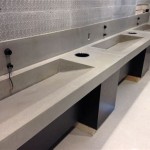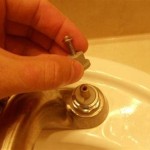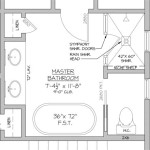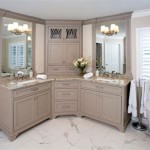Bathroom Sink Cabinets for Small Bathrooms: Optimizing Space and Style
Small bathrooms present unique design challenges. Maxizing space while maintaining functionality and aesthetic appeal requires careful consideration of every element, including the bathroom sink cabinet. These cabinets serve as both storage solutions and focal points, and choosing the right one can dramatically impact the perceived size and usability of a limited space. This article explores the various types of bathroom sink cabinets suitable for small bathrooms, offering insights into design considerations, material choices, and installation tips.
Understanding the Constraints of Small Bathroom Spaces
Before selecting a bathroom sink cabinet, a precise assessment of the bathroom's dimensions is crucial. Measure the available floor space, wall space, and ceiling height. Note the location of plumbing fixtures, doors, and windows, as these elements will influence the size and configuration of the cabinet. Consider the flow of traffic within the bathroom and ensure that the chosen cabinet does not obstruct movement. Small bathrooms often benefit from wall-mounted or corner cabinets as they free up valuable floor space.
Beyond physical dimensions, the overall design style of the bathroom influences the cabinet selection. A modern bathroom might benefit from a sleek, minimalist cabinet with clean lines, while a traditional bathroom might call for a cabinet with more ornate detailing. The color palette of the bathroom should also be considered. Lighter colors tend to make spaces feel larger and more open, while darker colors can create a sense of intimacy and depth. The cabinet material should complement the existing fixtures and finishes, such as the faucet, showerhead, and toilet.
Types of Bathroom Sink Cabinets for Small Spaces
Several types of bathroom sink cabinets are particularly well-suited for small bathrooms. Each offers unique advantages and disadvantages in terms of space utilization, storage capacity, and aesthetic appeal.
Wall-Mounted Cabinets: These cabinets are suspended from the wall, leaving the floor space beneath them open. This creates the illusion of a larger bathroom and makes cleaning easier. Wall-mounted cabinets are available in a variety of sizes and styles, from narrow rectangular designs to wider, more contemporary options. Installation requires careful attention to wall support and plumbing connections. The height of the cabinet can be adjusted to suit individual preferences and needs.
Corner Cabinets: Designed to fit snugly into the corner of a bathroom, these cabinets maximize otherwise underutilized space. Corner cabinets are typically triangular or curved in shape and offer a surprising amount of storage. They are an excellent option for bathrooms with unconventional layouts or limited wall space. However, corner cabinets may require custom plumbing modifications to accommodate their unique shape and placement.
Pedestal Sink Cabinets: These cabinets conceal the plumbing beneath a pedestal sink, providing a small amount of storage space. They are typically narrow and tall, making them suitable for very small bathrooms where space is at a premium. Pedestal sink cabinets can be freestanding or wall-mounted. However, their storage capacity is often limited to toiletries and cleaning supplies.
Vanity Cabinets with Integrated Sinks: These cabinets combine the sink and storage into a single unit. They are available in a wide range of sizes and styles, from compact models suitable for powder rooms to larger, more functional options for master bathrooms. Vanity cabinets with integrated sinks offer a seamless and streamlined look, and they are often easier to install than separate sink and cabinet combinations.
Freestanding Cabinets: While often associated with larger bathrooms, freestanding cabinets can be suitable for small spaces if chosen carefully. Opt for narrow, tall models with a minimal footprint. Ensure that the cabinet does not obstruct the flow of traffic within the bathroom. Freestanding cabinets offer the advantage of being easily moved or replaced, making them a flexible option for renters or those who anticipate future renovations.
Material Considerations for Bathroom Sink Cabinets
The choice of cabinet material is critical, as it affects the durability, aesthetics, and maintenance requirements of the cabinet. Bathrooms are typically humid environments, so it is essential to choose materials that are resistant to moisture and mildew.
Solid Wood: Solid wood offers a timeless and elegant look. It is durable and can be refinished if damaged. However, solid wood is susceptible to moisture damage if not properly sealed and maintained. It is also more expensive than other cabinet materials.
Plywood: Plywood is a more affordable alternative to solid wood. It is made from layers of wood veneer glued together under pressure. High-quality plywood is strong and resistant to warping. It is often used as a core material for cabinets with laminate or veneer finishes.
MDF (Medium-Density Fiberboard): MDF is an engineered wood product made from wood fibers and resin. It is smooth and uniform, making it ideal for painting. MDF is less expensive than solid wood or plywood, but it is more susceptible to moisture damage. It is best used in well-ventilated bathrooms with minimal exposure to water.
Laminate: Laminate is a synthetic material that is bonded to a core material, such as plywood or MDF. It is durable, water-resistant, and easy to clean. Laminate is available in a wide range of colors and patterns, including wood-grain finishes. It is a popular choice for bathroom cabinets due to its affordability and versatility.
Metal: Metal cabinets offer a sleek and modern look. They are durable, water-resistant, and easy to clean. Stainless steel is a common choice for bathroom cabinets, but other metals, such as aluminum and brass, are also available. Metal cabinets can be powder-coated in a variety of colors to match the bathroom's decor.
Glass: Glass can be used for cabinet doors or shelves. It adds a touch of elegance and allows light to pass through, making the bathroom feel more open. Tempered glass is a safe and durable option for bathroom cabinets.
Optimizing Storage Space in Small Bathroom Cabinets
Maximizing storage space is essential in small bathrooms. Consider incorporating features that enhance the functionality of the cabinet, such as adjustable shelves, pull-out drawers, and door-mounted organizers.
Adjustable Shelves: Adjustable shelves allow for customized storage solutions. They can be moved up or down to accommodate items of different sizes. This is particularly useful for storing tall bottles or bulky items.
Pull-Out Drawers: Pull-out drawers provide easy access to items stored in the back of the cabinet. They are ideal for storing toiletries, cosmetics, and cleaning supplies. Consider adding dividers or organizers to keep the drawers tidy and organized.
Door-Mounted Organizers: Door-mounted organizers utilize the often-overlooked space on the inside of the cabinet doors. They can be used to store small items, such as brushes, combs, and toothpaste. These organizers are available in a variety of styles, including racks, baskets, and pouches.
Vertical Storage: Utilize vertical space by installing tall, narrow cabinets or shelving units. This helps to keep items off the countertop and floor, creating a cleaner and more organized look.
Hidden Storage: Consider incorporating hidden storage solutions, such as a false drawer that conceals a small compartment or a mirror with a built-in medicine cabinet. These discreet storage options can help to declutter the bathroom without sacrificing style.
Installation Tips for Bathroom Sink Cabinets
Proper installation is crucial for ensuring the stability and longevity of the bathroom sink cabinet. If you are not comfortable with plumbing and carpentry work, consider hiring a professional installer. Before beginning the installation, turn off the water supply to the bathroom and disconnect the old sink and cabinet.
For wall-mounted cabinets, ensure that the wall is strong enough to support the weight of the cabinet and its contents. Use appropriate anchors and fasteners to secure the cabinet to the wall studs. Level the cabinet carefully to prevent it from tilting or wobbling.
For vanity cabinets with integrated sinks, ensure that the sink is properly sealed to prevent leaks. Connect the plumbing fixtures according to the manufacturer's instructions. Test the drain and water supply for leaks before completing the installation.
For freestanding cabinets, ensure that the cabinet is level and stable. If necessary, use shims to adjust the height of the cabinet legs. Secure the cabinet to the wall if it is prone to tipping.
After installing the cabinet, clean up any debris and dispose of the old sink and cabinet properly. Inspect the installation carefully to ensure that everything is functioning correctly and that there are no leaks.
Lighting Considerations for Bathroom Sink Cabinets
Proper lighting is essential for creating a functional and visually appealing bathroom. Consider incorporating lighting fixtures that illuminate the sink area and provide adequate task lighting for grooming and other activities.
Vanity Lighting: Install vanity lights above or on either side of the mirror to provide even illumination for the face. Avoid placing a single light directly above the mirror, as this can cast unflattering shadows. LED vanity lights are energy-efficient and provide bright, natural-looking light.
Under-Cabinet Lighting: Install LED strip lights under the bathroom sink cabinet to provide ambient lighting and highlight the cabinet's design. Under-cabinet lighting can also make it easier to find items stored inside the cabinet.
Recessed Lighting: Recessed lighting provides general illumination for the bathroom. Install recessed lights in the ceiling to supplement the vanity lighting and create a well-lit space.
Natural Light: Maximize the use of natural light by installing a window or skylight in the bathroom. Natural light can make a small bathroom feel larger and more open.

22 Inch Narrow Depth Console Bath Vanity Custom Options

Bathroom Vanity Ideas The Home Depot

Bathroom Vanity Ideas The Home Depot

15 Small Bathroom Vanity Ideas That Rock Style And Storage

30 Black Modern Bathroom Vanity With Faucet Medicine Cabinet And Linen Side Option

Bathroom Vanity Ideas The Home Depot

16 Small Modern Bathroom Vanity Grey Oak Finish

Bathroom Vanity Styles To Fit Your Space Forbes Home

Bathroom Vanity Ideas The Home Depot

24 Wenge Brown Modern Bathroom Vanity With Mirror
Related Posts







